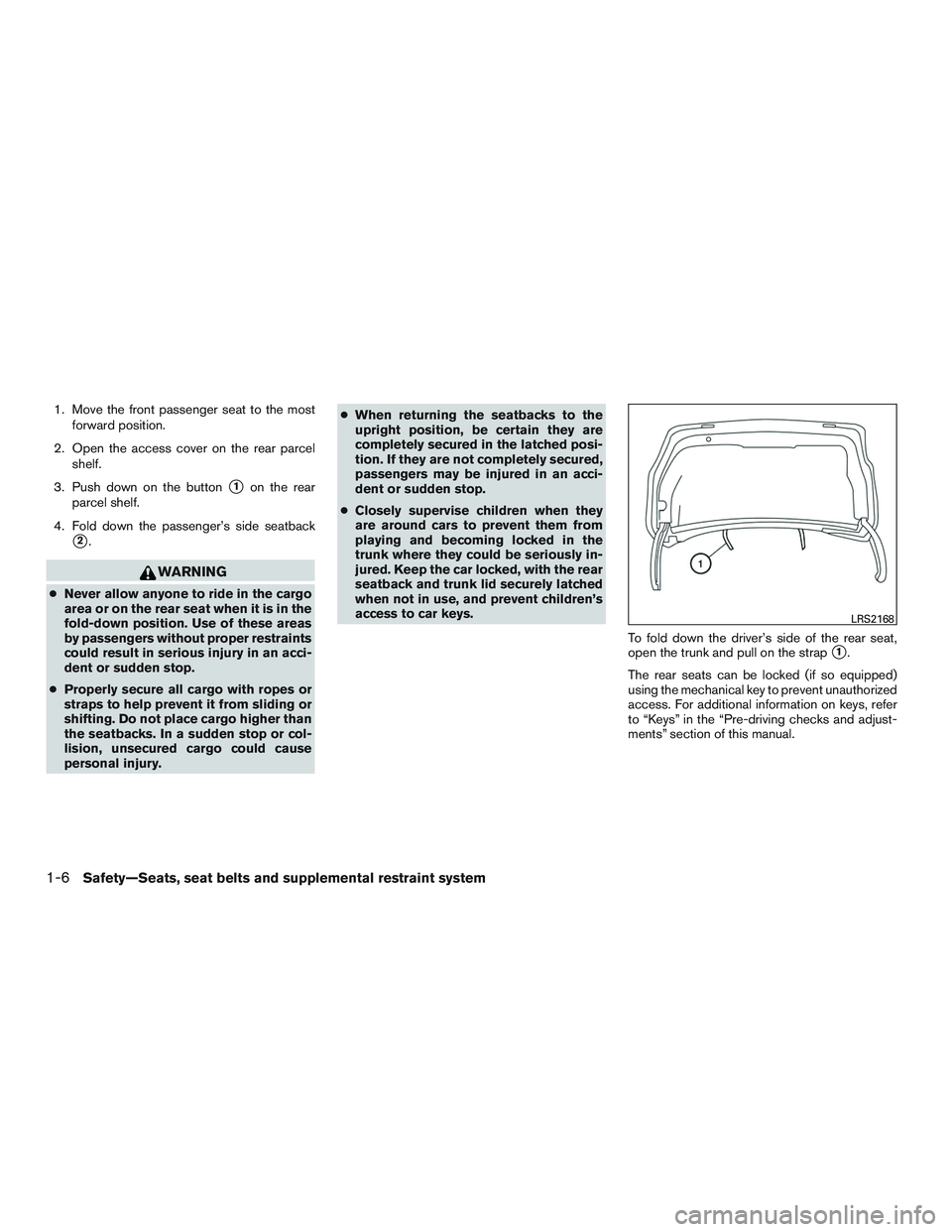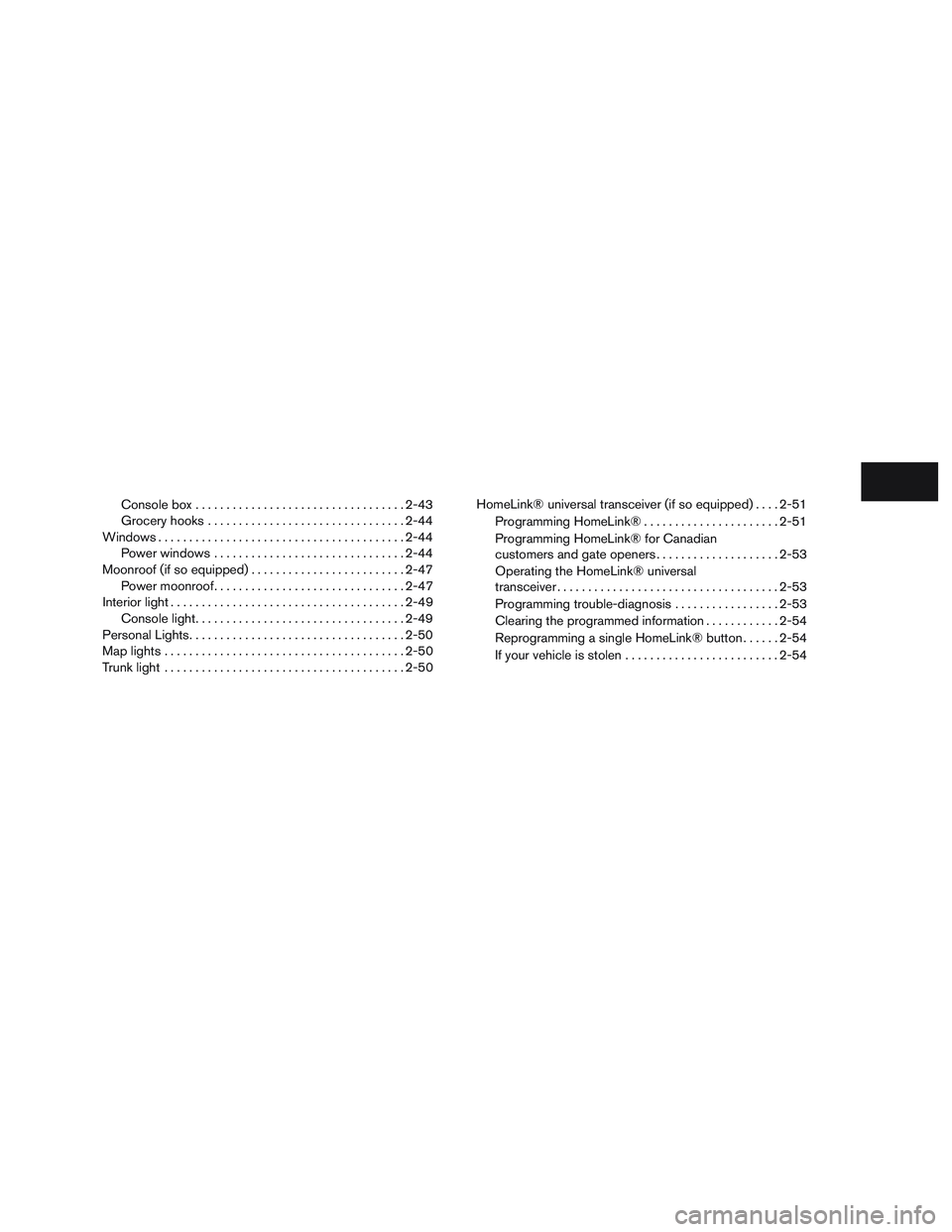Page 14 of 441
1. Rear window defroster switch (P. 2-31)
2. Interior trunk lid release (P. 3-30)
3. Trunk lid (P. 3-30)
4. Opener operation (P. 3-30)
5. Rearview camera (if so equipped)(P. 4-10)
6. Replacing bulbs (P. 8-30)
7. Fuel-filler cap, recommended fuel
(P. 3-32, 9-2)
8. Fuel-filler door (P. 3-32)
9. Child safety rear door lock (P. 3-4)
Refer to the page number indicated in
parentheses for operating details.
LII2171
EXTERIOR REAR
0-4Illustrated table of contents
Page 15 of 441
1. Interior trunk access (P. 1-2)
2. Power moonroof (if so equipped)(P. 2-47)
3. Sun visors (P. 3-35)
4. Interior lights, illuminated entry (P. 2-49)
5. HomeLink® Universal Transceiver
(if so equipped) (P. 2-51)
6. Automatic anti-glare rearview mirror
(if so equipped) (P. 3-36)
7. Glove box (P. 2-41)
8. Cup holders (P. 2-41 )
9. Console box (P. 2-41)
10. Front seat (P. 1-2)
11. Rear seat (P. 1-2)
12. Rear armrest, cup holders
(P. 1-2, 2-42)
Refer to the page number indicated in
parentheses for operating details.
LII2172
PASSENGER COMPARTMENT
Illustrated table of contents0-5
Page 17 of 441
22. Vehicle Dynamic Control OFF switch(P. 2-39)
Trunk opener release switch (P. 3-30)
Heated steering wheel switch
(if so equipped) (P. 2-38)
Warning system switch
(if so equipped) (P. 2-38)
* Refer to the Navigation System Owner’s manual
(if so equipped)
See the page number indicated in paren-
theses for operating details.
Illustrated table of contents0-7
Page 25 of 441
Seat lifter (driver’s seat)
Push the front or rear end of the switch up or
down to adjust the angle and height of the seat
cushion.
Lumbar support (if so equipped for
driver’s seat)
The lumbar support feature provides adjustable
lower back support to the driver. Push the switch
forward or backward to adjust the seat lumbar
area.
FOLDING REAR SEAT
Interior trunk access
The trunk can be accessed from the driver side
and passenger side of the rear seat for loading
and unloading, as shown.
WRS0752WRS0743
WRS0166
Safety—Seats, seat belts and supplemental restraint system1-5
Page 26 of 441

1. Move the front passenger seat to the mostforward position.
2. Open the access cover on the rear parcel shelf.
3. Push down on the button
�1on the rear
parcel shelf.
4. Fold down the passenger’s side seatback
�2.
WARNING
● Never allow anyone to ride in the cargo
area or on the rear seat when it is in the
fold-down position. Use of these areas
by passengers without proper restraints
could result in serious injury in an acci-
dent or sudden stop.
● Properly secure all cargo with ropes or
straps to help prevent it from sliding or
shifting. Do not place cargo higher than
the seatbacks. In a sudden stop or col-
lision, unsecured cargo could cause
personal injury. ●
When returning the seatbacks to the
upright position, be certain they are
completely secured in the latched posi-
tion. If they are not completely secured,
passengers may be injured in an acci-
dent or sudden stop.
● Closely supervise children when they
are around cars to prevent them from
playing and becoming locked in the
trunk where they could be seriously in-
jured. Keep the car locked, with the rear
seatback and trunk lid securely latched
when not in use, and prevent children’s
access to car keys.
To fold down the driver’s side of the rear seat,
open the trunk and pull on the strap
�1.
The rear seats can be locked (if so equipped)
using the mechanical key to prevent unauthorized
access. For additional information on keys, refer
to “Keys” in the “Pre-driving checks and adjust-
ments” section of this manual.
LRS2168
1-6Safety—Seats, seat belts and supplemental restraint system
Page 83 of 441

Console box.................................. 2-43
Grocery hooks ................................ 2-44
Windows ........................................ 2-44
Power windows ............................... 2-44
Moonroof (if so equipped) ......................... 2-47
Power moonroof ............................... 2-47
Interior light ...................................... 2-49
Console light .................................. 2-49
Personal Lights ................................... 2-50
Map lights ....................................... 2-50
Trunk light ....................................... 2-50HomeLink® universal transceiver (if so equipped)
....2-51
Programming HomeLink® ......................2-51
Programming HomeLink® for Canadian
customers and gate openers ....................2-53
Operating the HomeLink® universal
transceiver .................................... 2-53
Programming trouble-diagnosis .................2-53
Clearing the programmed information ............2-54
Reprogramming a single HomeLink® button ......2-54
If your vehicle is stolen ......................... 2-54
Page 85 of 441
22. Vehicle Dynamic Control OFF switch(P. 2-39)
Trunk opener release switch (P. 3-30)
Heated steering wheel switch
(if so equipped) (P. 2-38)
Warning system switch
(if so equipped) (P. 2-38)
* Refer to the Navigation System Owner’s manual
(if so equipped)
See the page number indicated in paren-
theses for operating details.
1. Tachometer
2. Warning/indicator lights
3. Vehicle Information Display
4. Speedometer
5. Fuel gauge
6. Odometer/Twin trip odometer 7. Engine coolant temperature gauge
LIC2254
METER AND GAUGES
Instruments and controls2-3
Page 95 of 441

●If the light illuminates while driving,
avoid sudden steering maneuvers or
abrupt braking, reduce vehicle speed,
pull off the road to a safe location and
stop the vehicle as soon as possible.
Driving with under-inflated tires may
permanently damage the tires and in-
crease the likelihood of tire failure. Se-
rious vehicle damage could occur and
may lead to an accident and could result
in serious personal injury. Check the
tire pressure for all four tires. Adjust the
tire pressure to the recommended
COLD tire pressure shown on the Tire
placard located in the driver’s door
opening to turn the low tire pressure
warning light OFF. If the light still
comes on while driving after adjusting
the tire pressure, a tire may be flat. If
you have a flat tire, replace it with a
spare tire as soon as possible.
● When a spare tire is mounted or a wheel
is replaced, tire pressure will not be
indicated, the TPMS will not function
and the low tire pressure warning light
will flash for approximately 1 minute.
The light will remain on after 1 minute.
Contact a NISSAN dealer as soon as
possible for tire replacement and/or
system resetting. ●
Replacing tires with those not originally
specified by NISSAN could affect the
proper operation of the TPMS.
CAUTION
●The TPMS is not a substitute for the
regular tire pressure check. Be sure to
check the tire pressure regularly.
● If the vehicle is being driven at speeds
of less than 16 MPH (25 km/h), the
TPMS may not operate correctly.
● Be sure to install the specified size of
tires to the 4 wheels correctly.
Master warning light
When the ignition is in the ON position, the master
warning light illuminates if any of the following are
displayed on the vehicle information display.
● No key warning
● Low fuel warning
● Low windshield-washer fluid warning
● Parking brake release warning
● Door/trunk open warning
● Loose fuel cap
● Check tire pressure warning
Power steering warning light
WARNING
●If the engine is not running or is turned
off while driving, the power assist for
the steering will not work. Steering will
be harder to operate.
● When the power steering warning light
illuminates with the engine running,
there will be no power assist for the
steering. You will still have control of
the vehicle, but the steering will be
much harder to operate. Have the power
steering system checked by a NISSAN
dealer.
When the ignition switch is in the ON position,
the power steering warning light illuminates. After
starting the engine, the power steering warning
light turns off. This indicates that the electric
power steering system is operational. If the
power steering warning light illuminates while the
engine is running, it may indicate the power
steering system is not functioning properly and
may need servicing. Have the hydraulic pump
electric power steering system checked by a
NISSAN dealer. For additional information, refer
to “Power steering” in the “Starting and driving”
section of this manual.
Instruments and controls2-13